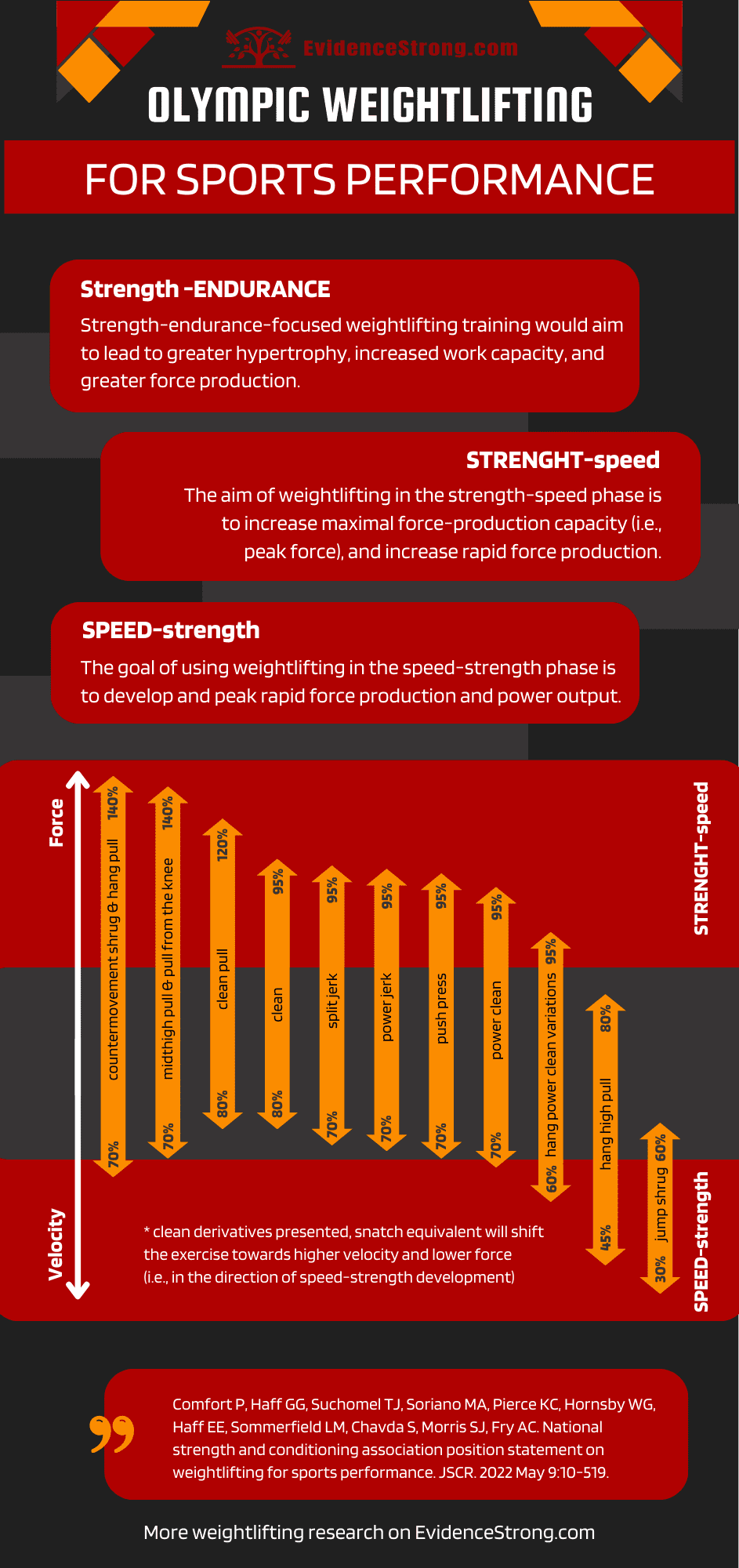Olympic weightlifters are strong and powerful but can the athletes from other sports gain some of these characteristics through doing weightlifting as their accessory or preparatory training?
The quick answer is YES, and here is why:
Why should you consider doing weightlifting with athletes from other sports?
Here are the reasons why Olympic weightlifting is useful in athletes from other sports:
- Olympic weightlifting improves force-production capabilities,
- Olympic weightlifting movements are similar to (and correlate in performance with) jumping, sprinting, and change of direction in terms of the rapid and forceful extension of the knees, hips, and ankles (plantar flexion); in particular, the second pull phase and the drive phase during the jerk (and its variations) facilitate the production of the greatest forces, rate of force development, and power outputs,
- the transition phase in the pull, stimulates a stretch-shortening cycle response as does the dip in the jerk and its variations,
- countless options to choose between exercises that may be used to emphasize force production (clean variations for strength-speed) or emphasize movement velocity (snatch variations for speed-strength). Also, the actual adaptation will be achieved by the manipulation of the load used when performing these exercises.
How to use Olympic weightlifting to build better athletes in other sports?
You can use Olympic weightlifting to drive specific adaptations to support progress in the athlete’s main sport.
Using Olympic weightlifting to train STRENGTH-ENDURANCE
The aim of strength-endurance-focused weightlifting training would be to lead to greater hypertrophy, increased work capacity, and greater force production. A range of exercises could be used in this phase but these should be considered:
- an athlete’s technical competency,
- relative strength,
- the complexity of the chosen exercise(s),
- and the goal(s) of the training phase.
If an athlete is unable to consistently perform the prescribed exercise(s) for more repetitions because of either poor technique or a lack of positional strength, other exercises should be prescribed, or the load should be reduced.
To improve work capacity the exercises that have a moderate-large displacement and allow for moderate to moderately heavy loads to be used (i.e., pulling derivatives).To minimize fatigue within a training session, and provide an opportunity for additional coaching (e.g., in less-experienced athletes), exercises (e.g., pulling derivatives, catching derivatives) could be used (3 sets of 10 repetitions) using cluster sets (e.g., 2 sets of 5 repetitions within each set of 10) with a 30- to 40-second rest interval.
Using Olympic weightlifting to train STRENGTH-SPEED
The aim of weightlifting in strength-speed phase is to:
- increase maximal force-production capacity (i.e., peak force),
- increase rapid force production.
The strength-speed phase could be focused on general strength (e.g., 3 sets of 5 repetitions, moderately heavy to heavy loads at 70-80% 1RM) or absolute strength (e.g., 3 sets of 3 repetitions, heavy to very heavy loads at 80-90% of 1RM). Weightlifting exercises that use heavier loads often have a decreased displacement (e.g., hang pull, pull from the knee).
Force production can be achieved by using exclusively catching or pulling derivatives but prescribing combinations of pulling, catching, and overhead pressing derivatives may prevent staleness while improving performance.
Using Olympic weightlifting to train SPEED-STRENGTH
The goal of using weightlifting in the speed-strength phase is to:
- develop rapid force production and power output,
- peak rapid force production and power output.
To achieve these qualities the combination of exercises that emphasize either force or velocity is recommended with a combination of both heavy and light loads. Speed-strength adaptations are specific to the loads used during the training, therefore the range of loads needs to be used to broaden the adaptations. Also, the total volume of training needs to be controlled to reduce fatigue.
Olympic weightlifting for sports - visual summary
Main results
Take home message
Original article
Comfort P, Haff GG, Suchomel TJ, Soriano MA, Pierce KC, Hornsby WG, Haff EE, Sommerfield LM, Chavda S, Morris SJ, Fry AC. National strength and conditioning association position statement on weightlifting for sports performance. The Journal of Strength & Conditioning Research. 2022 May 9:10-519.
You might want to read next
Stable and variable components of the lifts in Olympic weightlifting
